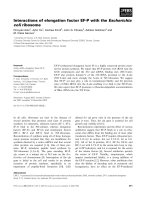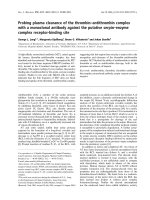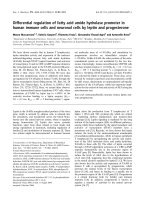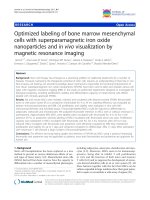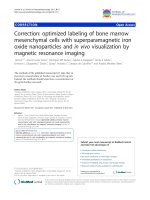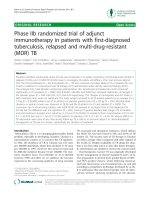Multivalent interactions of Nano-spaced dimers of N-acetylneuraminic acid analogues complex with H5N1 influenza viral Neuraminidase and Haemagglutinin - A molecular dynamics investigation
Bạn đang xem bản rút gọn của tài liệu. Xem và tải ngay bản đầy đủ của tài liệu tại đây (2.86 MB, 30 trang )
Int.J.Curr.Microbiol.App.Sci (2019) 8(1): 1517-1546
International Journal of Current Microbiology and Applied Sciences
ISSN: 2319-7706 Volume 8 Number 01 (2019)
Journal homepage:
Original Research Article
/>
Multivalent Interactions of Nano-spaced Dimers of N-acetylneuraminic
Acid Analogues Complex with H5N1 Influenza Viral Neuraminidase and
Haemagglutinin - A Molecular Dynamics Investigation
J. Jino Blessy1, D. Jawahar2 and D. Jeya Sundara Sharmila3*
1
Department of Bioinformatics, Karunya University, Karunya Nagar, Coimbatore-641 114,
Tamil Nadu, India
2
Directorate of Natural Resource Management, Tamil Nadu Agricultural University,
Coimbatore-641003, Tamil Nadu, India
3
Department of Nano Science and Technology, Tamil Nadu Agricultural University,
Coimbatore-641003, Tamil Nadu, India
*Corresponding author
ABSTRACT
Keywords
N-acetylneuraminic
acid analogues,
H5N1 influenza A
virus,
Neuraminidase,
Haemagglutinin and
Molecular dynamics
simulation
Article Info
Accepted:
12 December 2018
Available Online:
10 January 2019
Design of multivalent ligand is significant in restraining the interaction involved in the
binding of influenza virus to its host cell. This molecular dynamics (MD) simulation study
aims to study the mode of binding of dimeric NeuNAc analogues coupled by different
nano-spacers into the multimeric binding sites of neuraminidase and haemagglutinin of
influenza A H5N1 virus. In total, 80 NeuNAc analogue dimers were modeled and docked
against the binding sites of neuraminidase and haemagglutinin. The top scoring complexes
such as neuraminidase – 2-keto-3-deoxy-D-glycero-d-galacto-nononic acid (or KDN)
dimer coupled by 1-nano-linker, neuraminidase – KDN dimer linked by CH-C1 nanospacer, haemagglutinin – KDN dimer connected by CH-C1 nano-spacer and
haemagglutinin – KDN dimer joined by CH-N1 nano-spacer were taken in for the
conformational investigation by molecular dynamics (total 80ns) in aqueous environment.
The potential energy profile, RMSD, RMSF, protein – ligand contacts and intermolecular
hydrogen bond interactions suggest that the complexes were stable throughout the
trajectory of MD simulations. The ligand torsion report was calculated for each rotatable
bond of dimers of NeuNAc analogues which were bound to target proteins such as
neuraminidase and haemagglutinin. The binding energy and conformational study of the
complexes reveal that the nano-spacer coupled dimers of NeuNAc analogues may be used
as potential candidates for designing multivalent drugs to inhibit neuraminidase and
haemagglutinin and perhaps to prevent the viral spread.
Introduction
Multivalent interaction is one of the
characteristic features exhibited in the binding
of influenza virus to its host cell (1,2).
Multivalent interaction plays a crucial role in
carbohydrate recognition such as binding of
multiple copies of carbohydrates or
1517
Int.J.Curr.Microbiol.App.Sci (2019) 8(1): 1517-1546
oligosaccharides in the binding site of cell
surface receptor protein (3, 4). Due to the
significance of multivalency in biological
systems, research efforts are rising to explore
and rationalize the consequences of
multivalent ligands to develop potentially new
drugs (5, 6). Hence, a number of multivalent
bioactive compounds predominantly dimeric
forms of known therapeutic small molecules
are being considered as drug candidates (7).
Influenza
haemagglutinin
(HA)
and
neuraminidase (NA) are the target viral
proteins which have multimeric binding site
same
as
in
human
and
simian
immunodeficiency virus envelop proteins.
The virulence of avian H5N1 influenza A
virus is highly pathogenic and a pandemic
threat to humans and animals (8). In its
pathogenesis, human H5N1 influenza disease
differs significantly from seasonal human
influenza viral disease. In H5N1 infection, the
primary cause of death is owing to viral
pneumonia. However, the virus also
distributes beyond the respiratory tract with
hypercytokinemia and leads to multi-organ
failure (9). The earlier in-vitro, in-vivo studies
and clinical research recorded that various
cytokines and chemokines including TNFα,
IFN-α/β, IFN-γ, IL-6, IL-1, IL-8, MIP-1,
MIG, IP-10, MCP-1 and RANTES were
induced by H5N1 viruses that leads to H5N1
infection and cell death in both humans and
animals (10-12).
Influenza A virus consists of glycoproteins
termed as haemagglutinin (HA) and
neuraminidase (NA) along with M1 and M2
proteins to manage the entry and the exit of
viral particle through the host cell receptors.
In the host cell, haemagglutinin binds to the
terminal sialic acid receptor on cell surface
and the neuraminidase cleaves the terminal
sialic acid from cell surface glycoconjugates
to assist the viral shedding (13). It is reported
that Influenza A virus haemagglutinin has 18
different antigens and neuraminidase has 11
different antigens (14). On the basis of
nucleotide
sequence
phylogeny,
haemagglutinin has divided into two groups,
group_1 follows: H1, H2, H5, H6, H8, H9,
H11, H12, H13, H16, and H17 and group_2
follows: H3, H4, H7, H10, H14, and H15
(15). Neuraminidase also forms two groups,
group_1 follows N1, N4, N5, and N8 and
group_2 follows: N2, N3, N6, N7, and N9.
The viruses with several combinations of HA
and NA subtypes are found in waterfowl of
avian species which are the asymptomatic
carriers (16).
N- acetylneuraminic acids (NeuNAc or
Neu5Ac) are the most abundant sialic acids,
the derivatives of neuraminic acid, a ninecarbon acidic monosaccharides commonly
found in mammals and other vertebrates.
They are found in the cell surface of glycan of
glycoconjugates (gangliosides). They play a
vital role in carbohydrate-protein recognition
event leading to cell adhesion, cell-cell
interactions and cell-virus recognition events.
The NeuNAc inhibits sialic acid binding
proteins such as sialoadhesins, selectins, and
influenza hemagglutinins and may show
potent antiviral, antibacterial and antiinflammatory effects (17, 18).
In the present work, computational screening
of NeuNAc analogue library against H5N1
viral neuraminidase and haemagglutinin was
carried out using molecular docking
techniques. In total, 153 NeuNAc analogues
(Supplement Table 1) were screened against
the H5N1 viral neuraminidase and
haemagglutinin. The top five scoring
NeuNAc analogues from neuraminidaseNeuNAc
analogue
complex
and
haemagglutinin- NeuNAc analogue complex
were
retrieved/selected
for
further
dimerization study. Molecular modeling of
homo dimerization of NeuNAc analogues
were done in which eight nanospacers of
1518
Int.J.Curr.Microbiol.App.Sci (2019) 8(1): 1517-1546
length in nano meter range were used
separately to join the top five dock scoring
NeuNAc analogues (Figure 1) resulting in a
total of eighty homo NeuNAc analogue
dimers that were screened against the
neuraminidase and haemagglutinin using
molecular docking. The conformational
behavior of individual complexes such as
neuraminidase-2-keto-3-deoxy-D-glycero-dgalacto-nononic acid (or KDN) dimer joined
by 1-Linker (Figure 1), neuraminidase-KDN
dimer coupled by CH-C1 nano-spacer,
haemagglutinin- KDN dimer attached by CHC1 nano-spacer and haemagglutinin- KDN
dimer connected by CH-N1 nano-spacer were
studied using molecular dynamics simulation
each for 20ns.
Materials and Methods
Molecular docking
Molecular docking is a computational method
to predict the favorable binding orientation
between the receptor – ligand to form a
favorable complex (19). The three
dimensional structure of neuraminidase (PDB
ID: 2HTQ) (16) and haemagglutinin (PDB
ID: 4KDN_A) (20) were retrieved from
protein data bank (PDB). The binding site
residues
of
neuraminidase
and
haemagglutinin structure were referred from
PDBsum database (16, 20) as follows:
neuraminidase binding site residues are
ARG118, GLU119, ASP151, ARG152,
ARG156, TRP178, ILE222, ARG224,
GLU227, ALA246, GLU276, GLU277,
ARG292, TYR347, ARG371 and TYR406.
The haemagglutinin binding site residues are
TYR95, LEU133, GLY134, VAL135,
SER136, SER137, TRP153, ILE155, HIS183,
GLU190
and
LEU194.
Both
the
neuraminidase and haemagglutinin proteins
were prepared, optimized and minimized
using protein preparation wizard of Maestro
v9.2 (21). The preparation of protein structure
involves the following steps: (i) import the
present protein structure from PDB into
Maestro environment, (ii) to locate the water
molecules or delete the water molecules, (iii)
if the binding sites have dimer or multimer
binding sites or multiple chains, remove the
duplicate chains, (iv) adjust the protein
structure for metal ions and cofactors, (v)
check the ligand bond orders and formal
charges, (vi) adjust the ionization and
tautomerization state, (vii) protein preparation
is the final step to refine the protein structure
and (viii) finally review the prepared
structures. Energy minimization was done to
clean the steric clashes using Schrodinger
restrained minimization (21) in which the
heavy atoms are restrained but the output
structures do not deviate too much from the
input structure. Energy minimization was
done using molecular mechanics force field
Optimized Potentials for Liquid Simulations
(OPLS-2005) (22). The minimization gets
completed once the RMSD reaches the cutoff
of 0.3Å. The optimization was done to refine
the hydrogen atoms. 3D coordinates from the
2D representation of NeuNAc analogue
dimers were generated using LigPrep tool of
Schrödinger suite (23). For each successfully
processed 2D structure, LigPrep generates a
single, low-energy, 3D structure with correct
chiralities and also produces a number of
structures with different ionization states,
tautomers, stereochemistries and ring
conformations. It also eliminates the unfit
molecule through different criteria such as
molecular weight and types of functional
groups present. Docking investigation was
carried out using Glide v5.7 (24). The
receptor grid of 20×20×20 Å3 was generated
around the binding sites of neuraminidase and
haemagglutinin separately using Glide v5.7.
Glide applies a sequence of hierarchical filters
to search for feasible locations of ligand into
the binding site (25). The optimized
analogues were flexibly docked in the grid
box of the receptor using Monte Carlo based
1519
Int.J.Curr.Microbiol.App.Sci (2019) 8(1): 1517-1546
simulated algorithm (MCSA) minimization.
The two docking procedures followed were
Glide standard precision (SP) and extra
precision (XP). The difference between SP
and XP docking is that the SP programs
identify the ligands which were responsible
for binding and XP docking generates
different poses for each successful entered
ligand to get a well accurate ranking of least
energy models of the complex. The docking
pose of each ligand were ranked based on
docking score (XPGscore) and docking
energy (Glide energies). The ligand with least
XPGscore indicates the better binding affinity
towards the binding site residues.
Screening of NeuNAc analogues library
The modeled NeuNAc analogues library
(Supplement Table 1) was screened against
influenza
H5N1
neuraminidase
and
haemagglutinin
using
Glide
standard
precision (SP) and extra precision (XP)
docking method. Based on the docking score
and energy, top five scored NeuNAc
analogues complex with each neuraminidase
and haemagglutinin were considered for
further dimerization Studies. The top five
docking score and energy of each
Neuraminidase- NeuNAc analogues complex
and Haemagglutinin- NeuNAc analogues
complex were shown in Table 1.
Modeling of NeuNAc analogue dimers
The following analogues Benzyl-α-5-amino5d-KDN, 4-Guaniduno-Neu5Ac2en, 4-Oamidinomethyl-Neu5Ac2en,
4-aminoNeu5Ac2en and 5-d-KDN from the top five
Neuraminidase- NeuNAc analogues complex
and another five analogues KDN, N-glycolylNeuNAc, N-crotonoyl-NeuNAc, Neu5Gc and
5-N-thioAc-NeuNAc
from
the
Haemagglutinin- NeuNAc analogues complex
were selected for modeling their homo dimers
coupled
by
eight
different
nano-
spacers/linkers using chemical drawing
software chemsketch from ACD Labs. The
modeled NeuNAc analogue dimers coupled
by nano-spacers/linkers were shown in Figure
1.
Molecular dynamics simulation
The Molecular dynamics simulations were
carried out for the following complex of
influenza neuraminidase – KDN dimer joined
by 1-Linker, neuraminidase – KDN dimer
attached by CH-C1 nano-spacer and influenza
haemagglutinin – KDN dimer connected by
CH-C1 nano-spacer and haemagglutinin –
KDN dimer coupled by CH-N1 nano-spacer
each for 20ns simulation run using Desmond
v3.2 software of Schrödinger suite (26). The
simulation was carried out to study the
stability, conformational change and natural
dynamics of the complex in aqueous
environment. Desmond is a program designed
for explicit solvent simulations i.e., water
molecule along with any ions that may
present in solvent environment. The force
filed computation used in our study is
molecular mechanics force field of OPLS2005 (22). Each complex was solvated using
TIP3P water model in an orthorhombic box of
suitable size with periodic boundary
conditions. The whole system was neutralized
by replacing solvent molecules along with
adding counter ions Na+ and Cl− to balance
the net charge of the complex. The whole
system of neuraminidase – KDN dimer joined
by 1-Linker complex and that is coupled by
CH-C1 nano-spacer complex consist of
approximately 43,354 and 43,304 atoms
respectively. haemagglutinin – KDN dimer
linked by CH-C1 nano-spacer complex and
that is connected by CH-N1 nano-spacer
complex contain 62,092 and 61,883 atoms
respectively. The above said complexes were
simulated through multistep default protocol
formulated in Desmond with a series of
restrained minimizations using constant
1520
Int.J.Curr.Microbiol.App.Sci (2019) 8(1): 1517-1546
number of atom (N), pressure (P) and
temperature (T) (NPT) ensemble. The system
was equilibrated for the simulation time of 12
picoseconds at the temperature of 300 K and
pressure at 1.01325 bar. During simulation,
each trajectory data frames were collected for
every 4.8 ps. Particle-mesh Ewald method
were used to compute Long-range
electrostatic interactions (27, 28) and Van der
waals (VDW) cut off at 9Å. The hydrogen
bond geometry constraints were satisfied
using SHAKE algorithm (29). The whole
system of neuraminidase – KDN dimer joined
by 1-Linker as well as coupled by CH-C1
nano-spacer complex, haemagglutinin – KDN
dimer linked by CH-C1 nano-spacer as well
as connected by CH-N1 nano-spacer complex
were analyzed to ascertain their structural
stability, dynamics behavior of the complex
and their binding nature in water environment
using Desmond simulation analysis protocols.
Results and Discussion
Molecular modeling and docking studies of
dimers of NeuNAc analogues
To study the fitting of nano-spaced dimers of
NeuNAc analogue into the binding sites of
H5N1 influenza A viral neuraminidase and
haemagglutinin, the following linkers/ nanospacers having dimensions in nanometer
range were chosen for further modeling and
simulation studies: 1-Linker of size 2.99nm,
CH-C1 nano-spacer of size 2.83nm and CHN1 nano-spacer of size 2.25nm were used to
couple the KDN dimers (Figure 2).
Neuraminidase - NeuNAc analogue dimers
complex
In total, eighty NeuNAc analogue dimers
(Figure 1) were modeled and docked against
the binding sites of H5N1 neuraminidase. The
NeuNAc analogue dimers KDN-1-Linker and
KDN- CH-C1 Spacer shows favorable
interaction towards the binding sites of
neuraminidase with docking XPGScores of 15.09 and -15.00 respectively and docking
glide energy of -48.63 and -66.93 kcal/mol
respectively (Table 2).
Haemagglutinin
dimers complex
-
NeuNAc
analogue
Eighty NeuNAc analogue dimers were also
screened against the binding site of H5N1
haemagglutinin. The NeuNAc analogue
dimers KDN joined by CH-C1 nano-spacer
and KDN coupled by CH-N1 nano-spacer
show docking score (XPG) of -11.31 and 10.80 respectively and glide docking energy
of -56.24 and -50.11 kcal/mol respectively
(Table 2).
Molecular dynamics simulation
In current study, the dynamic behavior of
NeuNAc analogue dimers fit into the
multimeric
binding
sites
of
H5N1
neuraminidase - KDN dimer joined by 1Linker complex, neuraminidase- KDN dimer
joined by CH-C1 nano-spacer complex,
H5N1 haemagglutinin- KDN dimer joined by
CH-C1
nano-spacer
complex
and
haemagglutinin- KDN- CH-N1 Spacer
complex were analyzed from the trajectory
records acquired from every 20ns MD
simulation.
The conformational changes of the complex
were checked using Desmond Simulation
Quality Analysis and Event Analysis
protocol. Past NMR study revealed the
benefits of multivalency in which the
zanamivir resistant mutants of influenza A
virus strains were inhibited by multiple copies
of zanamivir conjugated in polymer chain
poly-L-glutamine. These multivalent drug
varieties demonstrate better viral inhibition
due to steric effects and increased affinity
(30).
1521
Int.J.Curr.Microbiol.App.Sci (2019) 8(1): 1517-1546
Neuraminidase- KDN dimer joined by 1Linker complex
The energy transition of the system along
with the maintenance of potential energy
(E_P), volume, temperature and pressure are
shown in Figure 3 (A) during 20 ns
simulation run. The essential insight into the
protein structural conformation throughout
the simulation is recorded as protein – ligand
root mean square deviation (RMSD) and
Protein RMSD (left Y-axis) is based on the
Cα atom selection (Figure 4). The protein
RMSD was in the acceptable range of 0.7 –
1.5 Å. Ligand RMSD (right Y-axis) depicts
the steady nature of the ligand towards the
protein binding sites (Figure 4 (A)). The Root
Mean Square Fluctuation (RMSF) is
calculated for characterizing local changes in
protein side chain. The tails (N- and Cterminal) of the protein fluctuates more than
other part of the protein. RMSF of the present
protein fluctuates between 0.4 – 2.8 Å (Figure
5 (A)). In an earlier dimeric study, zanamivir
dimeric conjugates show pharmacokinetic
parameters and neuraminidase inhibitory
activity against H5N1 influenza (31).
Interactions of KDN dimer joined by 1-Linker
in the binding pocket of neuraminidase were
monitored throughout the molecular dynamics
simulation of 20ns. Those interactions are
depicted as protein – ligand contacts such as
hydrogen bonds, hydrophobic, ionic and
water bridges (Figure 6 (A)). The hydrogen
bond interactions that play major role during
the simulations for neuraminidase- KDN
dimer joined by 1-Linker complex were
calculated for 20000ps. In total, eleven
intermolecular hydrogen bonds were found to
interact towards the binding site of
neuraminidase. The binding site residues
GLU277, GLU276, ARG292, ARG371,
THR369, SER370, GLU432, and TYR347
were participated in intermolecular hydrogen
bonding throughout the trajectory data. The
hydrogen atom 85(H) of KDN dimer coupled
by 1-Linker formed a hydrogen bond with
oxygen atom OE2 of an acidic polar residue
GLU277 with a distance of 1.71 Å, the
hydrogen atom 84(H) involved in a H-bond
with oxygen atom OE2 of acidic polar residue
GLU276 with a distance of 1.82 Å, the
oxygen atom 98(O) showed a hydrogen bond
with HH12 of side chain of basic polar
residue ARG292 with a distance of 1.60 Å,
the oxygen atom 98(O) participated in a
hydrogen bond with HH22 of basic polar side
chain residue ARG371 with a distance of 1.58
Å, the oxygen atom 37(O) contributed to a
hydrogen bond with HH12 of basic polar side
chain residue ARG371 with a distance of 1.71
Å, the hydrogen atom 68(H) showed a Hbond with oxygen atom (O) of polar side
chain residue THR369 with a distance of 1.72
Å, the oxygen atom (O) exhibited a H-bond
with H of basic polar side chain residue
ARG371 with a distance of 2.23 Å, the
oxygen atom (O) displayed H-bond with HG
of polar side chain residue SER370 with a
distance of 1.95 Å, the hydrogen atom 61(H)
involved in a H-bond with oxygen atom of
acidic polar residues GLU432 with a distance
of 1.90 Å, the oxygen atom (O) participated
in a H-bond with HH of polar side chain
residue TYR347 with a distance of 1.73 and
the hydrogen atom 69(H) showed a H-bond
with OH of polar side chain residue TYR347
with a distance of 1.95 Å (Figure 7 and Table
3). It was also reported in a previous NMR
experimental study concerning the importance
of carbohydrate interaction towards the polar
amino acid residues (32, 33).
Neuraminidase - KDN dimer coupled by
CH-C1 nano-spacer complex
The energy trajectory suggests the steadiness
of the complex (Figure 3 (B)) and RMSD of
neuraminidase - KDN dimer coupled by CHC1 nano-spacer complex is as shown in
Figure 4(B). Protein RMSD (left Y-axis)
1522
Int.J.Curr.Microbiol.App.Sci (2019) 8(1): 1517-1546
fluctuates between the range of 0.2 – 1.6 Å
and ligand RMSD (right Y-axis) indicates that
the ligand was fit towards the protein binding
sites (Figure 4 (B)). RMSF of present protein
chain fluctuates between the range of 0.4 –
2.0 Å (Figure 5 (B)). Protein – ligand contact
shows the presence of hydrogen bonds,
hydrophobic, ionic and water bridges (Figure
6 (B)). During the simulation, direct
intermolecular hydrogen bonds play a major
role. Totally, there were nine hydrogen bond
interactions with the binding site residues
ARG152, GLU119, TYR406, ARG292,
ARG371 and TYR347.
Fig.1 The structure and abbreviation of NeuNAc analogues coupled with different Linkers/NanoSpacers of length in nm
1523
Int.J.Curr.Microbiol.App.Sci (2019) 8(1): 1517-1546
Fig.2 The NeuNAc analogue dimers of KDN joined by 1-Linker, KDN connected by CH-C1
nano-spacer and KDN linked by CH-N1 nano-spacer
2.99 nm
2.83 nm
2. 25nm
1524
Int.J.Curr.Microbiol.App.Sci (2019) 8(1): 1517-1546
Fig.3 Energy diagram of (A) Neuraminidase - KDN dimer joined by 1-Linker complex, (B)
Neuraminidase - KDN dimer coupled by CH-C1 nano-spacer complex, (C) Haemagglutinin KDN dimer coupled by CH-C1 nano-spacer complex and (D) Haemagglutinin - KDN dimer
connected by CH-N1 nano-spacer complex for each 20ns respectively
1525
Int.J.Curr.Microbiol.App.Sci (2019) 8(1): 1517-1546
Fig.4 Protein – Ligand RMSD of (A) Neuraminidase - KDN dimer joined by 1-Linker complex,
(B) Neuraminidase - KDN dimer coupled by CH-C1 nano-spacer complex, (C) Haemagglutinin KDN dimer coupled by CH-C1 nano-spacer complex and (D) Haemagglutinin - KDN dimer
connected by CH-N1 nano-spacer complex for each 20ns respectively
1526
Int.J.Curr.Microbiol.App.Sci (2019) 8(1): 1517-1546
Fig.5 RMSF of (A) Neuraminidase - KDN dimer joined by 1-Linker complex, (B)
Neuraminidase - KDN dimer coupled by CH-C1 nano-spacer complex, (C) Haemagglutinin KDN dimer coupled by CH-C1 nano-spacer complex and (D) Haemagglutinin - KDN dimer
connected by CH-N1 nano-spacer complex for each 20ns respectively
1527
Int.J.Curr.Microbiol.App.Sci (2019) 8(1): 1517-1546
Fig.6 Protein – Ligand contact of (A) Neuraminidase - KDN dimer joined by 1-Linker complex,
(B) Neuraminidase - KDN dimer coupled by CH-C1 nano-spacer complex, (C) Haemagglutinin KDN dimer coupled by CH-C1 nano-spacer complex and (D) Haemagglutinin - KDN dimer
connected by CH-N1 nano-spacer complex for each 20ns respectively
)
1528
Int.J.Curr.Microbiol.App.Sci (2019) 8(1): 1517-1546
Fig.7 A: 3D render of Neuraminidase bound with KDN dimer joined by 1-Linker complex and
B: Intermolecular hydrogen bonding of the complex for 20 ns simulation run (Note:
H-bond back bone;
H-Bond side chain;
water bridge)
A:
B:
1529
Int.J.Curr.Microbiol.App.Sci (2019) 8(1): 1517-1546
Fig.8 A: 3D render of Neuraminidase bound with KDN dimer coupled by CH-C1 nano-spacer
complex and B: Intermolecular hydrogen bonding of the complex for 20 ns simulation run (Note:
H-bond back bone;
H-Bond side chain;
water bridge)
A:
B:
1530
Int.J.Curr.Microbiol.App.Sci (2019) 8(1): 1517-1546
Fig.9 A: 3D render of Haemagglutinin bound with KDN dimer coupled by CH-C1 nano-spacer
complex and B: Intermolecular hydrogen bonding of the complex for 20 ns simulation run (Note:
H-bond back bone;
H-Bond side chain;
water bridge)
A:
B:
1531
Int.J.Curr.Microbiol.App.Sci (2019) 8(1): 1517-1546
Fig.10 A: 3D render of Haemagglutinin bound with KDN dimer connected by CH-N1 nanospacer complex and B: Intermolecular hydrogen bonding of the complex for 20 ns simulation run
(Note:
H-bond back bone;
H-Bond side chain;
water bridge)
A:
B:
1532
Int.J.Curr.Microbiol.App.Sci (2019) 8(1): 1517-1546
Fig.11 Ligand Torsion Profile for Neuraminidase - KDN dimer joined by 1-Linker complex for
20 ns simulation run
1533
Int.J.Curr.Microbiol.App.Sci (2019) 8(1): 1517-1546
Fig.12 Ligand Torsion Profile for Neuraminidase - KDN dimer coupled by CH-C1 nano-spacer
complex for 20 ns simulation run
1534
Int.J.Curr.Microbiol.App.Sci (2019) 8(1): 1517-1546
Fig.13 Ligand Torsion Profile for Haemagglutinin - KDN dimer coupled by CH-C1 nano-spacer
complex for 20ns simulation run
1535
Int.J.Curr.Microbiol.App.Sci (2019) 8(1): 1517-1546
Fig.14 Ligand Torsion Profile for Haemagglutinin - KDN dimer connected by CH-N1 nanospacer complex for 20 ns simulation run
1536
Int.J.Curr.Microbiol.App.Sci (2019) 8(1): 1517-1546
Table.1 Glide dock score, Glide dock energy and inter molecular hydrogen bond interaction of
NeuNAc analogue monomer complex with influenza H5N1 viral proteins
neuraminidase and haemagglutinin
Sl.No
NeuNAc
Analogues
1
Benxyl-α-5amino-5d-KDN
2
4-GuanidunoNeu5Ac2en
3
4-OamidinomethylNeu5Ac2en
4
4-AminoNeu5Ac2en
5
5-d-Kdn
H5N1 Neuraminidase
Glide
Glide
Neuraminidase
Docking Docking
Protein
Score
Energy
Residues
Atoms
kcal/mol
-12.65
-37.61
GLU:119
OE2
ARG:118
HH22
TRY:406
OH
ARG:371
HH22
TYR:347
HH
ARG:292
HH12
ARG:292
HH22
GLU:277
OE2
GLU:276
OE2
-12.52
-55.25
ARG:118
HH22
ARG:371
HH22
GLU:119
OE2
GLU:277
OE2
ARG:371
HH12
ARG:292
HH22
ALA:246
O
ARG:152
HH22
-12.15
-40.42
ARG:371
HH22
ARG:371
HH12
ARG:292
HH22
ARG:292
HH12
GLU:277
OE2
GLU:277
OE2
GLU:277
OE2
ASP:151
OD2
ARG:152
HH22
ARG:152
HH22
-12.13
-45.45
GLU:119
OE2
ASP:151
OD1
ARG:152
HH21
ASP:151
OD2
ARG:152
HH22
ARG:371
HH12
TYR:347
HH
-11.87
-26.93
GLU:227
OE2
GLU:277
OE2
TYR:406
OH
1537
Ligand
Atom
38 (H)
O
30 (H)
23 (O)
15 (O)
48 (O)
48 (O)
36 (H)
37 (H)
8 (O)
8 (O)
48 (H)
45 (H)
47 (O)
47 (O)
34 (H)
19 (O)
O
O
46 (O)
46 (O)
44 (H)
43 (H)
45 (H)
34 (H)
14 (O)
13 (O)
26 (H)
41 (H)
19 (O)
33 (H)
13 (O)
8 (O)
40 (O)
29 (H)
31 (H)
23 (H)
Distance
(Å)
2.281
1.871
1.605
1.918
2.004
1.926
1.853
1.776
1.693
2.396
2.130
2.360
2.145
1.600
2.134
2.169
1.946
2.308
2.141
1.993
1.831
2.050
1.631
2.185
1.936
2.434
2.083
1.732
2.049
1.990
2.008
1.960
1.683
1.930
1.924
1.901
1.802
Int.J.Curr.Microbiol.App.Sci (2019) 8(1): 1517-1546
Sl.No
NeuNAc
Analogues
1
KDN
2
N-GlycolylNeuNAc
3
N-CrotonoylNeuNAc
4
Neu5Gc
5
5-N-thioAcNeuNAc
6
Co-crystal
NAG_SIA
ARG:292
HH22
ARG:371
HH22
ARG:371
HH12
ARG:292
HH12
TYR:347
HH
ARG:118
HH22
H5N1 Haemagglutinin
Glide
Glide
Haemagglutinin
Docking Docking
Protein
Score
Energy
Residues
Atoms
kcal/mol
-8.97
-34.8
LYS:193
HZ3
GLU:190
OE2
SER:136
HG
VAL:135
O
LEU:133
O
SER:137
OG
-8.45
-40.37
GLU:190
OE2
LEU:133
O
VAL:135
O
SER:136
HG
SER:136
HG
SER:137
OG
-8.38
-39.77
LEU:133
O
VAL:135
O
SER:136
HG
SER:137
OG
GLU:190
OE2
LYS:193
HZ3
-8.23
-38.80
LEU:133
O
VAL:135
O
SER:136
HG
SER:137
OG
LYS:193
HZ3
-8.20
-39.24
LEU:133
O
VAL:135
O
SER:136
HG
SER:137
OG
GLU:190
OE2
LYS:193
HZ3
-5.26
-31.16
GLU:190
OE2
SER:137
H
SER:136
HG
LEU:133
O
1538
32 (H)
O
O
32 (O)
O
O
Ligand
Atom
O
25 (H)
O
24 (H)
23 (H)
30 (H)
27 (H)
34 (H)
33 (H)
O
O
39 (H)
28 (H)
37 (H)
O
34 (H)
29 (H)
O
35 (H)
34 (H)
O
39 (H)
O
27 (H)
34 (H)
O
33 (H)
28 (H)
40 (O)
H40
O12
O12
H58
1.897
2.172
1.738
1.679
2.329
1.707
Distance
(Å)
1.730
2.283
2.163
2.199
1.979
1.923
1.982
1.933
1.715
2.194
2.304
1.853
2.175
1.918
2.291
1.977
2.119
1.712
2.074
1.827
2.362
2.008
1.646
2.060
2.071
2.304
1.933
2.270
1.709
2.350
2.070
2.129
1.919
Int.J.Curr.Microbiol.App.Sci (2019) 8(1): 1517-1546
Table.2 Enhanced Glide dock score, Glide dock energy and inter molecular hydrogen bond
interaction of dimers of NeuNAc analogues complex with influenza H5N1 Neuraminidase and
influenza H5N1 Haemagglutinin viral proteins
H5N1 Neuraminidase
Sl.No
NeuNAc
Glide
Glide
Neuraminidase Protein
Analogues
Docking Docking Residues
Atoms
Score
Energy
kcal/mol
KDN-1-Linker -15.09
-48.63
GLU:432
OE1
1
ARG:371
H
THR:369
O
THR:369
O
ARG:371
HH22
ARG:371
HH12
TYR:347
HH
ARG:292
HH12
ARG:292
HH22
GLU:119
OE2
KDN-CH-C1
-15.00
-66.93
GLU:432
OE1
2
Spacer
ARG:371
H
TYR:347
OH
ARG:371
HH12
ARG:118
HH22
TYR:406
OH
GLU:119
OE2
ARG:292
HH12
GLU:276
OE2
Zanamivir
-9.10
-39.23
ARG:152
O
3
TRP:178
H38
TRP:178
H40
ASP:151
H39
ASP:151
H43
ARG:118
O42
ARG:371
O42
TYR:347
O6
GLU:276
H37
H5N1 Haemagglutinin
Sl.No
NeuNAc
Glide
Glide
Haemagglutinin Protein
Analogue
Docking Docking Residues
Atoms
dimers at sialic Score
Energy
acid binding
kcal/mol
site
KDN-CH-C1
-11.31
-56.24
GLU:190
OE2
1
Spacer
GLU:190
OE2
SER:137
H
1539
Ligand
Atom
61 (H)
O
69 (H)
68 (H)
98 (O)
98 (O)
29 (O)
37 (O)
37 (O)
87 (H)
61 (H)
94 (O)
60 (H)
93 (O)
33 (O)
79 (H)
88 (H)
42 (O)
85 (H)
HH21
O
O
O
OD1
HH22
HH22
HH
OE2
Ligand
Atom
68 (H)
60 (H)
94 (O)
Distance
(Å)
2.112
1.957
2.261
2.047
2.034
1.720
2.032
1.826
1.872
1.832
1.895
2.099
2.137
1.796
1.616
1.816
1.744
1.673
1.732
1.988
1.728
2.167
1.893
2.298
1.767
1.951
2.024
1.971
Distance
(Å)
1.832
1.950
2.152
Int.J.Curr.Microbiol.App.Sci (2019) 8(1): 1517-1546
2
KDN-CH-N1
Spacer
-10.80
Sl.No
NeuNAc
Analogue
dimers at
different
binding sites
KDN-1-Linkerdimer
Glide
Glide
Docking Docking
Score
Energy
kcal/mol
-9.48
-47.36
2
5-d-KDN-CHN1-Spacerdimer
-8.27
-50.28
3
KDN-CH-N1Spacer-Dimer
-8.02
-49.24
4
5-d-KDN-CHC1-Spacer
Dimer
-6.73
-47.40
1
-50.11
VAL:135
O
LEU:133
O
SER:145
O
SER:146
HG
LYS:144
HZ2
LYS:114
HZ3
LYS:114
HZ2
SER:145
O
SER:145
O
SER:132
O
VAL:135
O
LEU:133
O
LEU:133
O
LYS:193
HZ3
Haemagglutinin Protein
Residues
ASN:88
ALA:87
LYS:70
LYS:106
ILE:268
GLU:104
HIS:107
THR:267
GLU:103
ILE:268
LYS:106
LYS:270
ALA:87
THR:267
GLU:103
LYS:106
GLU:104
GLU:103
GLU:103
LYS:106
LYS:270
1540
Atoms
OD1
O
HZ1
HZ1
H
OE2
NE2
HG1
OE2
O
HZ1
HZ1
O
HG1
O
HZ1
OE2
O
OE2
HZ1
HZ1
66 (H)
67 (H)
89 (H)
38 (O)
93 (O)
41 (O)
87 (O)
83 (H)
85 (H)
87 (H)
59 (H)
60 (H)
52 (H)
O
Ligand
Atom
1.700
2.066
2.009
2.224
1.775
2.181
2.291
1.754
1.824
2.276
2.081
2.495
2.143
1.903
Distance
(Å)
H84
H85
37O
98O
O
H70
H54
O16
H86
H61
O41
O85
H83
O17
H58
O32
H90
H88
H70
O29
O
2.150
1.773
1.809
1.912
1.973
1.998
2.357
2.001
1.717
2.373
1.844
1.724
1.748
1.890
1.765
1.919
2.425
1.926
1.694
1.977
1.799
Int.J.Curr.Microbiol.App.Sci (2019) 8(1): 1517-1546
Table.3 Inter molecular hydrogen bond distance for dimers of NeuNAc analogues:
Neuraminidase - KDN dimer joined by 1-Linker complex, Neuraminidase - KDN dimer coupled
by CH-C1 nano-spacer complex, Haemagglutinin - KDN dimer coupled by CH-C1 nano-spacer
complex and Haemagglutinin - KDN dimer connected by CH-N1 nano-spacer complex each
20ns respectively
Sl.No
1
Dimer
Neu5Ac
analogues
KDN-1Linker
2
KDN-CHC1 Spacer
Sl.No
Dimer
Neu5Ac
analogues
H5N1 Neuraminidase
MD
Total NO. of Protein
simulation interaction
Residues
GLU:277
GLU:276
ARG:292
20ns
11
ARG:371
ARG:371
THR:369
ARG:371
SER:370
GLU:432
TYR:347
TYR:347
ARG:152
GLU:119
20ns
9
TYR:406
ARG:292
ARG:371
TYR:347
TYR:347
ARG:371
ARG:371
H5N1 Haemagglutinin
MD
Total NO. of Protein
simulation interaction
Residues
(ns)
1
KDN-CHC1 Spacer
20ns
7
2
KDN-CHN1 Spacer
20ns
4
GLU:190
SER:137
VAL:135
SER:145
GLY:134
LYS:144
SER:146
LYS:144
SER:145
LYS:193
LEU:133
1541
Atoms
Ligand
Atoms
Distance
Å
OE2
OE2
HH12
HH22
HH12
O
H
HG
OE1
HH
OH
HH12
OE1
OH
HH12
HH12
HH
OH
H
HH22
85 (H)
84 (H)
98 (O)
98 (O)
37 (O)
68 (H)
O
O
61 (H)
O
69 (H)
40 (O)
88 (H)
79 (H)
42 (O)
42 (O)
93 (O)
67 (O)
O
33 (O)
1.71
1.82
1.60
1.58
1.71
1.72
2.23
1.95
1.90
1.73
1.95
2.20
1.97
1.97
1.60
1.63
1.82
1.89
1.85
2.44
Ligand
Atoms
Distance
Å
68 (H)
94 (O)
67 (H)
89 (H)
85 (H)
93 (O)
44 (O)
41 (O)
85 (H)
O
52 (H)
1.80
2.05
1.83
1.96
1.90
1.65
2.16
1.66
2.52
2.03
1.95
Atoms
OE2
HG
O
O
O
HZ1
HG
HZ1
O
HZ3
O

